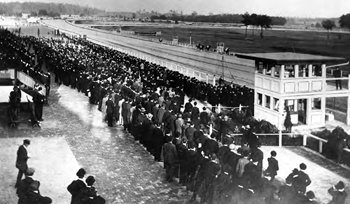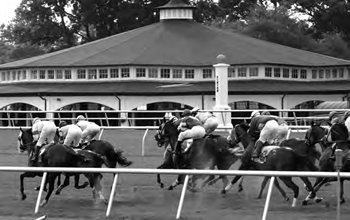History
Laurel Park first appeared on the racing scene on October 2, 1911. Its first meeting was held under the direction of the Laurel Four County Fair. Three years later, in 1914, New York City grocery entrepreneur James Butler purchased the track, installing renowned promotions king Col. Matt Winn as the track’s general manager. Winn is recognized as the man who put the Kentucky Derby on the racing map.
Under Butler’s stewardship, Laurel hosted three match races, beginning with Hourless vs. Omar Khayyam at one mile and one-quarter on October 18, 1917. Hourless had won the 1917 Belmont Stakes and Omar Khayyam had accounted for the Kentucky Derby that year. When the two horses met in the Brooklyn Derby earlier that year, Omar Khayyam prevailed by a nose, but in the Laurel match race Hourless rallied to win by a length in a time of 2:02.
The next year, top two-year-olds Billy Kelly and Eternal met in a six-furlong match race at Laurel, vying for a $20,000 pot. Eternal edged Billy Kelly by a head, and winning owner J. W. McClelland donated his purse money to the Red Cross. Then, on October 26, 1923, two-year-olds met again in a match race when Sarazin defeated Happy Thoughts at six furlongs.
In 1947, the Maryland Jockey Club, owners of Pimlico and Timonium at the time, purchased Laurel from the Butler estate with the idea of shifting the Pimlico meeting to Laurel. However, when the plan was not approved by the Maryland Legislature, the Maryland Jockey Club decided to sell the track to Baltimore industrialist Morris Schapiro, who appointed his youngest son John David Schapiro as the track’s new president. Laurel was sold to the Schapiros in 1950.
John D. Schapiro began revitalizing Laurel soon thereafter. He changed the track’s name to Laurel Race Course and introduced the Washington, D.C. International, a race designed to bring together the world’s best at one mile and one-half on the grass. England’s Wilwyn rallied from off the pace to win in the inaugural running of the International in 1952. The race went on to become an important fixture on United States and foreign racing calendars before being placed on hiatus in 1995.
In 1953 Laurel opened a new clubhouse and turf club, and in 1957 the grandstand was remodeled. In an effort to improve conditions for the International, Laurel lengthened its turf course from seven furlongs to one mile in 1959; simultaneously, the main track was extended from one mile to one mile and one-eighth.
Laurel remodeled its clubhouse and grandstand to accommodate winter racing in 1966, enclosing the track’s seating area with 30,000 square feet of half inch thick glass. Conversely, when Laurel was awarded the summer racing dates in 1982, the track installed an air conditioning system in the grandstand and clubhouse. In 1984, the 34-year Schapiro era ended with the sale of the track.
Renaissance at Laurel
Laurel entered a new era in December 1984, when Frank J. De Francis and his partners, Robert and John “Tommy” Manfuso, purchased the racetrack from Schapiro.
 An innovative Laurel project was the creation of the Sports Palace in 1985. It was the first of its kind in the horse racing world. The glittering $2 million facility was a bold innovation that combines the ambience of a plush casino with state-of-the-art technology which featured computerized handicapping and a video racing library. The concept of the Sports Palace has been widely copied by other tracks.
An innovative Laurel project was the creation of the Sports Palace in 1985. It was the first of its kind in the horse racing world. The glittering $2 million facility was a bold innovation that combines the ambience of a plush casino with state-of-the-art technology which featured computerized handicapping and a video racing library. The concept of the Sports Palace has been widely copied by other tracks.
In 1986, another $1 million was spent on additional improvements. The first floor of the clubhouse was totally renovated. The club bar and concession stands were enhanced with black marble, brass and neon accents. Three dining rooms were also part of the improvements, including the first floor “Silks Room” with its mahogany panelling and stained glass windows, where light fare is offered. The “Ruffian Room,” located on the mezzanine level, is reserved for special events, and the “Sky Suite Club,” for members, have also been completely redesigned in a most elegant fashion, making them among the finest at any racetrack in America.
In 1987, another $1 million was allocated to improvements, which centered on beautifying and modernizing the second floor of the clubhouse. Two new cinema theaters were added, one on the clubhouse second level and the other on the grandstand mezzanine. Important sporting events are televised in each theater.
Exterior improvements included repaving of the track apron, parking lots and stable area. Extensive landscaping has been completed around the track grounds, particularly in the paddock area with a new entrance and attractive white fencing. Also erected was a new barn in the International Village to accommodate foreign horses for the Turf Festival.
Inter-track wagering made its debut at Laurel in early 1988 with the Sports Palace playing a major role in attracting fans to the satellite-beamed races. Laurel fan support of Pimlico racing has continued to increase.
In August 1989, Frank J. De Francis died, but his vision lives on through his son, Joseph A. De Francis, who now serves as president of Laurel and Pimlico. Following in the footsteps of his father, De Francis introduced several concepts to Maryland racing. Under the younger De Francis’ control, Off-Track Wagering, full-card simulcasting and a renewed commitment to the patron have combined to rejuvenate the sport.
In October of 1994, Joe De Francis announced that the storied racing oval would return to its roots; the track was officially renamed Laurel Park. In addition, an aggressive, multi-million dollar renovation project was unveiled and a new department—Public Relations, under the direction of Karin De Francis—was created to focus on customer service.
Following his purchase of the ownership interests of Robert and John A. Manfuso, Jr., Joe De Francis guided the track to its most successful year ever in 1994 and topped the total betting handle record in 1995.
In 1997 major improvements were made to Laurel’s main entrance, the Grandstand interior and to backstretch barns. The new Main Line-1 features quadruple, large-screen TV theaters with desks and wireless mutuel terminals for the serious racing fans.
Another major improvement at Laurel was the complete rebuilding of the nine furlong racing strip in 1998. It was a massive undertaking, directed by John Passero, costing almost $2 million.
In 1999, at Laurel Park, the MJC broke ground on a new $1.85 million backstretch housing project, Laurel Commons, in cooperation with Laurel Quality of Life, Inc., the Enterprise Foundation, Inc. and the Ryan Family Foundation, Inc. In addition, Laurel Park, as part of a $16 million multi-year renovation plan, opened four premier Clubhouse areas: “Tycoons,” an upscale cigar and brandy bar with an excellent television presentation of racing and other sporting events; “Sunny Jim’s,” a simulcast theatre with individual carrels, and food & beverage service; “Clocker’s Corner,” a casual simulcast theatre and cafe in a convenient track-side location and the “Kelso Club,” a premier accommodation for VIP customers with concierge service.
In 2000, the Maryland Jockey Club and Maryland horsemen entered into a landmark revenue sharing agreement with the standardbred industry whereby net revenue from parimutuel handle on all wagers is shared 80% to the thoroughbred industry and 20% to the standardbred industry.
 The backstretch and racing surfaces at Laurel Park were closed from mid-June 2004 to early January 2005 as Magna Entertainment Corp. began a multi-million dollar renovation, which included the widening of both racing surfaces. The new main course, which has been raised and increased in width from 75 to 95 feet, now features one-turn mile races. The track’s composition of 89 percent sand and 11 percent silt and clay is identical to the old Laurel dirt surface. The new, sweeping turf course, which was widened from 75 feet to 142 feet, helped make the track a top simulcast signal. The turf accommodates six track configurations which were named All Along, Bowl Game, Kelso, Dahlia, Exceller and Fort Marcy, in honor of some of the great horses which have competed on the grass at Laurel Park.
The backstretch and racing surfaces at Laurel Park were closed from mid-June 2004 to early January 2005 as Magna Entertainment Corp. began a multi-million dollar renovation, which included the widening of both racing surfaces. The new main course, which has been raised and increased in width from 75 to 95 feet, now features one-turn mile races. The track’s composition of 89 percent sand and 11 percent silt and clay is identical to the old Laurel dirt surface. The new, sweeping turf course, which was widened from 75 feet to 142 feet, helped make the track a top simulcast signal. The turf accommodates six track configurations which were named All Along, Bowl Game, Kelso, Dahlia, Exceller and Fort Marcy, in honor of some of the great horses which have competed on the grass at Laurel Park.










